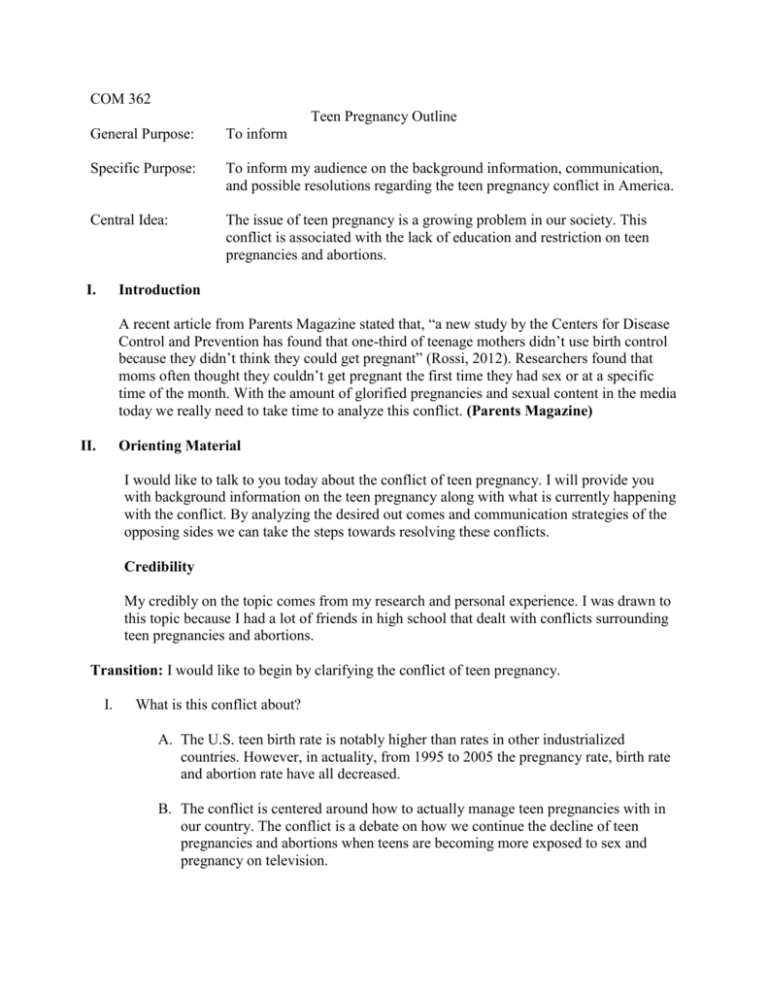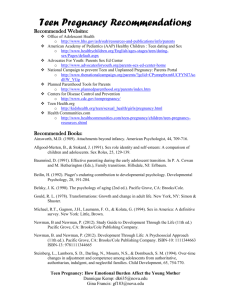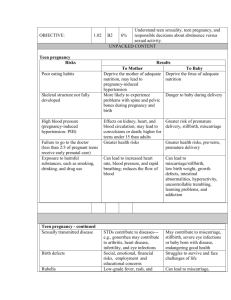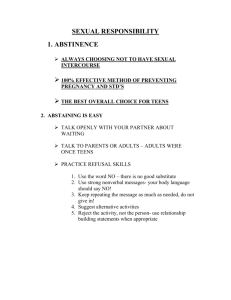
COM 362
Teen Pregnancy Outline
General Purpose:
To inform
Specific Purpose:
To inform my audience on the background information, communication,
and possible resolutions regarding the teen pregnancy conflict in America.
Central Idea:
The issue of teen pregnancy is a growing problem in our society. This
conflict is associated with the lack of education and restriction on teen
pregnancies and abortions.
I.
Introduction
A recent article from Parents Magazine stated that, “a new study by the Centers for Disease
Control and Prevention has found that one-third of teenage mothers didn’t use birth control
because they didn’t think they could get pregnant” (Rossi, 2012). Researchers found that
moms often thought they couldn’t get pregnant the first time they had sex or at a specific
time of the month. With the amount of glorified pregnancies and sexual content in the media
today we really need to take time to analyze this conflict. (Parents Magazine)
II.
Orienting Material
I would like to talk to you today about the conflict of teen pregnancy. I will provide you
with background information on the teen pregnancy along with what is currently happening
with the conflict. By analyzing the desired out comes and communication strategies of the
opposing sides we can take the steps towards resolving these conflicts.
Credibility
My credibly on the topic comes from my research and personal experience. I was drawn to
this topic because I had a lot of friends in high school that dealt with conflicts surrounding
teen pregnancies and abortions.
Transition: I would like to begin by clarifying the conflict of teen pregnancy.
I.
What is this conflict about?
A. The U.S. teen birth rate is notably higher than rates in other industrialized
countries. However, in actuality, from 1995 to 2005 the pregnancy rate, birth rate
and abortion rate have all decreased.
B. The conflict is centered around how to actually manage teen pregnancies with in
our country. The conflict is a debate on how we continue the decline of teen
pregnancies and abortions when teens are becoming more exposed to sex and
pregnancy on television.
Transition: Television is known for exaggerating societies flaws and teen pregnancy is one of
it’s most recent targets.
II.
What is currently going on in the conflict?
A. Currently, the media and our society is some what obsessed with teen pregnancy.
a.
In last weeks cable ratings “Teen Mom 2 the Check Up” ranked 7 out of a
100, surprisingly enough, this was a decline from last week. “The Secret Life
of an American Teenager” and “16 and Pregnant” are two more examples of
shows dealing with pregnancy that account for the highest viewer ratings for
their networks.
b. The increase of sex and teen pregnancy on television may have a direct
collation to how sexually active teens are.
B. In 2008, according to The Official Journal of the American Academy of Pediatrics,
“data from a national longitudinal survey of teens (12–17 years of age, monitored for
15–20 years of age) were used to assess whether exposure to televised sexual content
predicted subsequent pregnancy for girls or responsibility for pregnancy for boys
(Chandra et al., 2008)”. (Journal)
a. The results of this study showed that exposure of sexual content predicted an
increase in teen pregnancy. Teens who were exposed to high levels of
television sexual content (90th percentile) were twice as likely to experience a
pregnancy in the subsequent 3 years, compared with those with lower levels
of exposure (10th percentile) (Chandra et al., 2008)”.
b. Even though this was one of the first study’s that demonstrated a correlation
between the media and teen pregnancy, it is somewhat alarming.
Transition: Because the media can be so influential, we need to really analyze the valued
outcomes of parties involved in the conflict.
III.
What does each side want as an out come?
A. For the most part, teens don’t plan on becoming pregnant. There are numerous
conflicts that arise from becoming pregnant as a teen. The lives of the mother and the
child often suffer immensely. According to the book Teenage Pregnancy and
Poverty, “a child born to a teenage dropout is ten times more likely to live in poverty
by the time he or she is eight to twelve years old” (Miller, 1997, p. 57). (Book)
B. The scary side of this conflict is the small number of girls who are intentionally
getting pregnant in hopes of becoming a television star. These girls are deliberately
getting pregnant to pursue the medias gloried presentation of being a teen mom.
Transition: Teens need to know the truth about the responsibilities related with being a mother
and the consequences of having a child too young. How to educate these teens is where the
conflict truly resides.
IV.
Why isn’t communication working between one side and the other?
A. The two sides of the conflict are disagreeing on how to achieve their mutual goal of
lowering teen pregnancy rates.
a. The liberal version emphasizes the use of contraceptives and believes that the
more access and control women have regarding contraceptives the less likely
they are to become pregnant or have an abortion.
b. “Liberal” Contraceptive advertisement
c. According to an article published in The New York Times, “the conservative
narrative argues that it’s more important to promote chastity, monogamy and
fidelity than to worry about whether there is a prophylactic in every bedroom
drawer”(Douthat, 2012). (Newspaper)
d. Abortion rates are frequently higher in liberal states where access to abortions
is less restricted. Conservative states often practice “safe, legal and rare” when
it comes to abortions, this causes teen pregnancy rates to increase.
B. Despite their opposing viewpoints, the communication between the two sides is
improving.
a. According to absitenanceworks.org, “a recent national poll of parents
demonstrated that 90% want their children to know about the risks associated
with casual sex and the limitations of contraception” (NAEA office, 2011).
(Website)
Transition: This encouraging data shows that both sides of the conflict are somewhat willing to
find common ground.
V.
What would it take to resolve this conflict?
A. Resolving teen pregnancy is something I truly believe our society can achieve
through education.
a. We need to provide education to teens and young adults in their 20’s that
encourages them to take sex and pregnancy seriously. This includes
encouraging healthy relationships and personal responsibility along with
extensional information on contraceptives.
b. Along with education on contraceptives we must illuminate the option of
abstinence. Many people are quick to deny abstinence education because it
seems close-minded, but in reality, todays abstinence education curriculum
includes additional contraceptive methods.
B. As a society we must strive to strengthen our culture of personal responsibility
regarding sex, pregnancy and raising a child.
a. In order to do so, contraceptives need to be a common practice for people who
are sexually active and not ready for a child.
b. Due to the fact that sex is so prominent on television today we have to adjust
the promotion of contraceptives. If teen mom is what is popular with the
youth, we need to work that much harder to insure that using contraceptives is
a general practice for teens choosing to be sexually active.
Conclusion
I.
Summary Statement: In summary, the conflict surrounding teen pregnancy is a
disagreement over what and how to teach teens about sex. Teen pregnancy is on the
decline but with todays presentation of sex in the media we need to be prepared for what
the future may entail.
II.
Reinforce central idea statement: This conflict is associated with the lack of education
on the consequences of teen pregnancy. In order to solve this conflict, both sides must
work together to find the best means of sexual education for teens.
III.
Clincher: Is our current sexual education enough? As a society we need to take
responsibility, and take sex education to another level. Every child deserves the highest
quality a life possible and together we can make that happen.
References:
Centers for Disease Control and Prevention. (Producer). (2010). Teen pregnancy data. [Web
Graphic]. Retrieved from http://www.cdc.gov/TeenPregnancy/LongDescriptors.htm
(Graph)
Chandra, A., Martino, S., Collins, R., Elliot, M., Berry, S., Kanouse, D., & Miu, A. (2008). Does
watching sex on television predict teen pregnancy? findings from a national longitudinal
survey of youth. Retrieved from
http://www.pediatricsdigest.mobi/content/122/5/1047.short (Journal)
Douthat, R. (2012, February 18). The ‘safe, legal, rare’ illusion. The York Times, p. SR12.
(Newspaper)
Miller, B. (1997). Teenage pregnancy and poverty: The economic realities. (p. 57). New York,
NY: The Rosen Publishing Group. (Book)
MTV. (Producer). (2011). Teen mom 2 after show. [Print Photo]. Retrieved from
http://remotecontrol.mtv.com/category/shows/teen_mom_2/page/9/ (Photo)
NAEA office. (2011). F.A.Q. Retrieved from http://www.abstinenceworks.org/stats-and-factsmainmenu-52 (Website)
PSA. (Producer) (2011). Unplanned pregnancy prevention - awkward times [Web]. Retrieved
from http://www.youtube.com/watch?v=xm5YXaELbkI (video)
Rossi, H. (2012, January 20). Teen moms uneducated about pregnancy risk Parents, Retrieved
from http://www.parents.com/blogs/parents-news-now/2012/01/20/pregnancy/cdc-teenmoms-uneducated-about-pregnancy-risk/ (Magazine)
Sarah. (Producer) (2009). Sarah's journey through teen pregnancy. [Web Photo]. Retrieved from
http://www.littlepreggie.com/2010/11/true-stories-behind-the-scene/ (Photo)
Unplanned Pregnancy Prevention. (Producer). (2011). The too-skinny jean. [Print Photo].
Retrieved from http://bedsider.adcouncil.org/print-and-outdoor/ (Photo)
Walt Disney. (Producer). (2011). The secret life of the american teenager. [Print Photo].
Retrieved from http://www.dvdreleaseshop.com/products/The-Secret-Life-of-theAmerican-Teenager-DVD-Season-2-Boxset-DVDS-2063.html (Photo)





